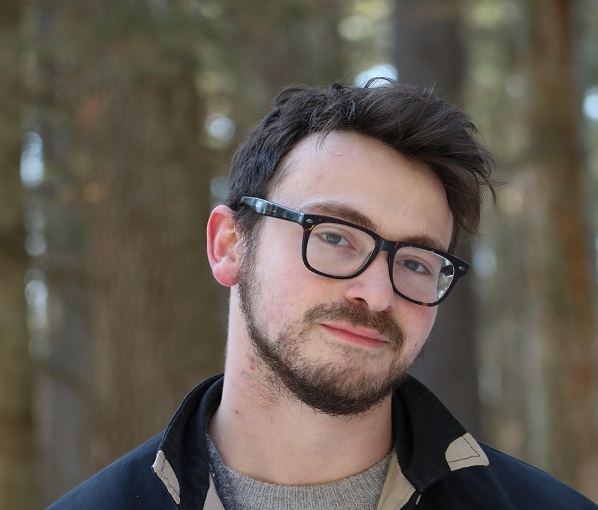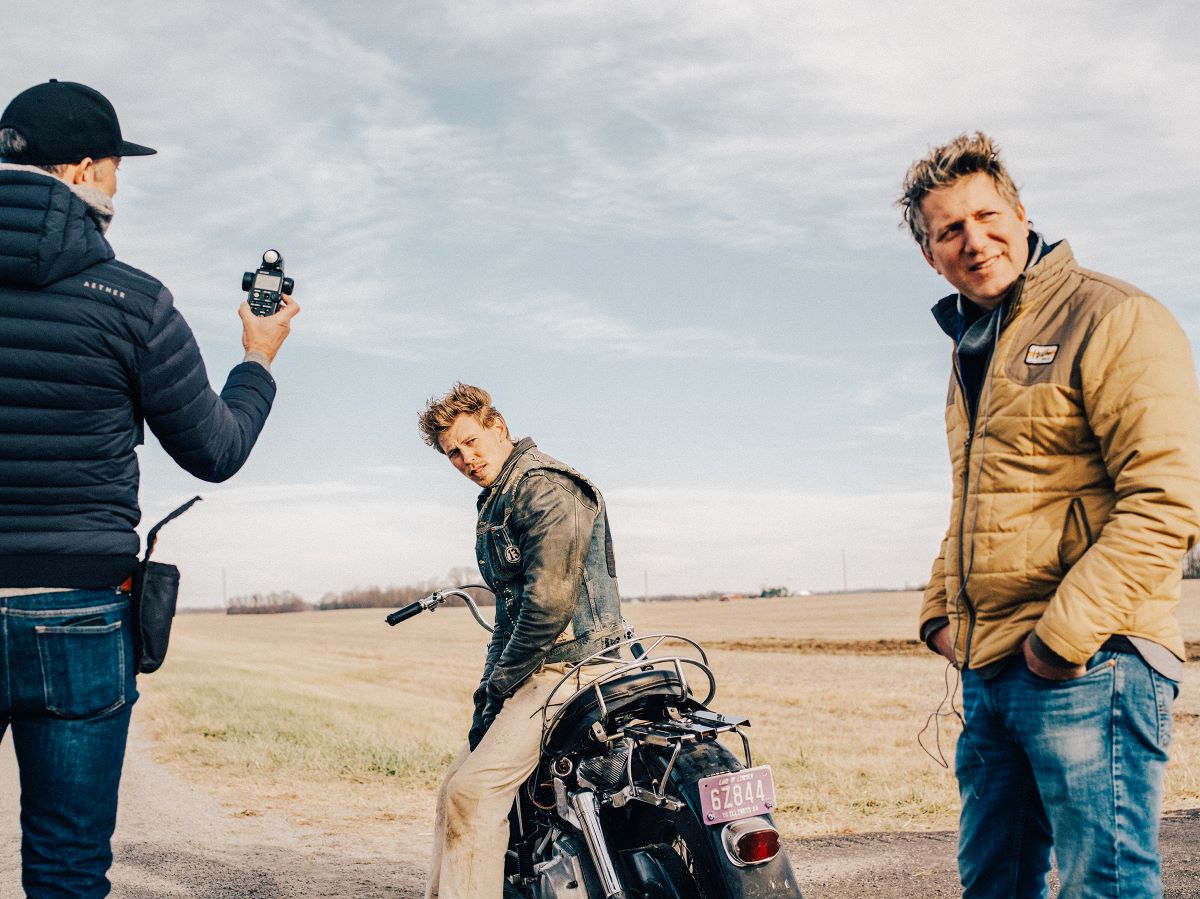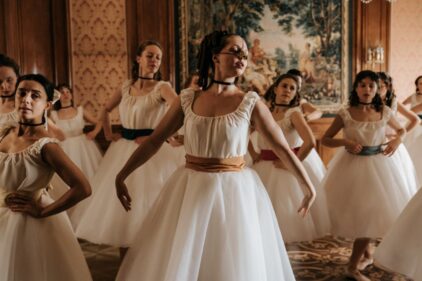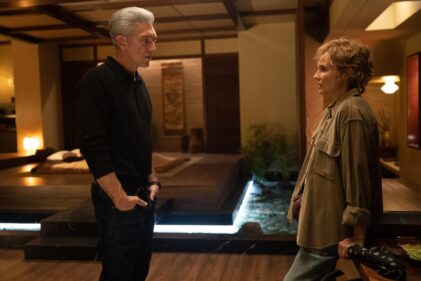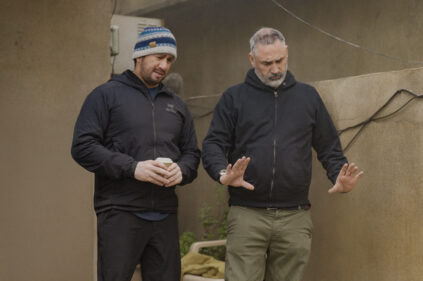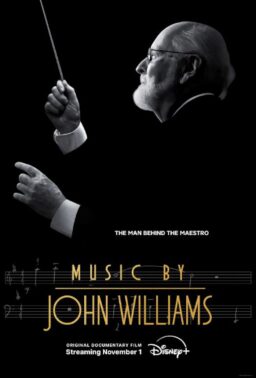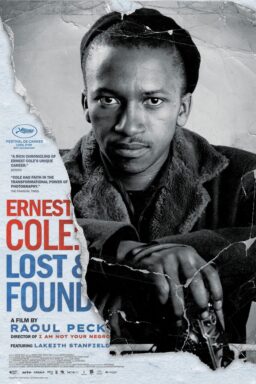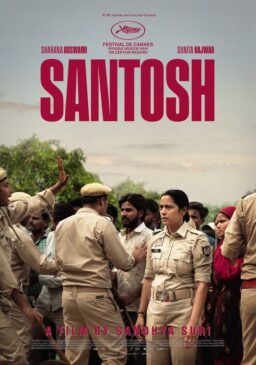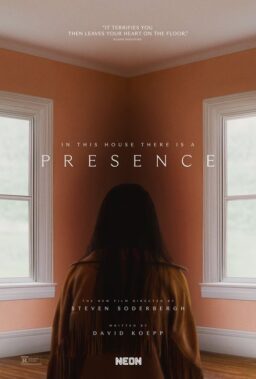With “The Bikeriders,” now in theaters, Jeff Nichols finally made the film he’d been dreaming about for over two decades: a tough, transportive drama about the rise and fall of a fictional Midwestern motorcycle club, as told through the lives of its members.
Directly inspired by Danny Lyon’s book of photography (for which the photographer and New Journalism icon embedded himself within the Chicago chapter of the Outlaws Motorcycle Club across the 1960s), Nichols’ decade-spanning saga traces the evolution of the Vandals from a local community for leather-clad outsiders most at home on the highway into an increasingly criminal underworld replete with gang rivalries, violent altercations, and dangerous drifters.
At the club’s center is its hardened leader, Johnny (Tom Hardy), who struggles to retain control over the subculture he helped to create, and Benny (Austin Butler), an impulsive young Vandal whose combustible tendencies set the group on a darker path. Though Benny is desperately in love with Kathy (Jodie Comer), who observes the club from a disapproving distance and fears for his safety, Johnny successfully competes for his affection and, over the years, all three of them make up a tumultuous pseudo-love triangle.
Most of the cast did their own riding, on period-accurate bikes, as Nichols captures the reckless and romanticized energy of a ’60s motorcycle riding subculture without sparing audiences from the rough, realistic details of its collapse. With one of the year’s most electric ensemble casts, including Mike Faist (“Challengers”), Boyd Holbrook (“Logan”), Norman Reedus (“The Walking Dead”), Emory Cohen (“Brooklyn”), and frequent collaborator Michael Shannon (“Take Shelter”), Nichols—best known for “Mud,” “Midnight Special,” and “Loving,” all atmospheric dramas set in the American South—crafts a thrilling, mournful ode to a lost era of rebellion on the open road.
Last fall, “The Bikeriders” was the closing-night selection of the 2023 Chicago International Film Festival; at its Oct. 22 screening at the Music Box Theatre, Nichols was honored with an Artistic Achievement Award, signifying a full-circle moment for the writer-director whose debut feature, “Shotgun Stories,” had its U.S. premiere in the same theater, at the same festival, in 2007. In her introduction, CIFF artistic director Mimi Plauché reflected that Nichols was 24 when he made “Shotgun Stories” on a shoestring budget with a then-unknown Michael Shannon; she also quoted Roger Ebert’s four-star review, in which he wrote, “It has qualities that may not come out in a trailer or in an ad but sink in when you have the experience of seeing it. Few films are so observant about how we relate with one another. Few are as sympathetic.”
The morning after, in his suite at the Peninsula Hotel, Nichols admitted he was still processing the experience. “That’s kind of what started it all,” he recalled of the support “Shotgun Stories” received from critics like Ebert and festivals like CIFF, even after being rejected by most major distributors. “It was pretty flattering.” In conversation with RogerEbert.com, Nichols reflected on his reputation as a distinctly American filmmaker, capturing life in an outlaw motorcycle club, the themes of ephemerality and transition that pervade his filmmaking, and his favorite stories from set.

This interview has been edited and condensed.
It’s been 20 years since you first came across Danny Lyon’s photography. What do you remember about that initial discovery, and what so struck you about these pictures?
If I’m getting really specific… It was 2003. I’d walked into my brother’s room in his apartment in Memphis. My older brother, Ben, was the cool one. Still is. He’s the lead singer of Lucero and is always reading the coolest books, listening to the coolest music. His room was littered with cool things. I looked down on the floor and saw this red-and-white book; on its cover was a black-and-white photograph of these five riders cresting the hill. And the bottom half of the cover was bright red, with “The Bikeriders” knocked out in real clean font.
This, I didn’t know at the time, was a reissue that had just come out. And I wanted it: the colors, the bikes, everything — just from that cover, to be honest. I immediately asked, “What is this?” When I first started sending the script out, I actually scanned that cover and put it on my script, because I just wanted that impression. I think, at some point, I talked to Danny, and he was like, “I didn’t like that cover.” [laughs] He liked the original cover—his cover—which totally makes sense. But I even liked the font.
You open it up, and the book goes through the entire culture of motorcycle riders. You’ve got Scrambles Track riders, you’ve got mechanics and people building bikes, but then you’ve also got this woman, Kathy, standing in her bathtub. They just felt like the best kinds of photographs, where you’re capturing people as they are, and those people happen to be really compelling.
I was—tangentially, through my brother—part of the punk-rock scene in Little Rock in the ’90s. I loved the detail those people put into their clothes and their style. And you could feel that same sense in these people. There’s a lot of care and thought that went into their style, even though it was a rough-edged kind of style. Their shirts were embroidered; they had these black Western shirts with white piping and beautifully embroidered patches on the back. Then, you get into the text of the book, and these romanticized pictures gain even more of an edge, because you start reading their words and getting this three-dimensional view of a subculture.
Photos have always been an inspiration to me for other films too; certainly, “Mud” was inspired by a book of photographs, [The Last River: Life Along Arkansas’s Lower White, by Turner Browne,] in large part. With those words, you get to see the backside of those photographs and hear the way they think. That’s when I fell in love. That’s when it became more than thinking, “These photos are cool.” I started thinking, “Aren’t these people interesting and frustrating and complex, and everything that you want out of a study of humanity?”

In both Lyon’s book and your film, the story brings a sense of reality to the iconography of the outlaw biker, contextualizing it within larger ’60s counterculture, but not at the expense of the romance, glory, and gratification of that lifestyle. We talk about Lyon’s book as saturation reporting, where you’re more swept up by the subjects than studying them from a sober perspective.
I call it a tension. You have these layers of experience with it — or at least I have, over the last 20 years. Because it starts with the photographs, and then you get into the interviews, and then you hear the people talking, and it doesn’t get easier; it actually gets more difficult. I think this is why it took me a long time to write it, to sit down and face it, because I wanted my film to do all those things, kind of at once. You get this romantic impression at some point in the film, but then the veneer starts to come off a little bit. You start to see the complications in these people. Then you go even further, and it gets downright brutal and tragic, at some point. I wanted to convey not just the first experience of looking at the book but the experience of living with that book for 20 years, which was a deeper experience. I wanted the film to feel like that, which was a hard thing to attempt, but I gave it my best shot.
That lived-in quality you describe feels relevant as well to the textured details you capture in these characters: the bikes, the throttles, the gloves in the back pockets of their pants, the jackets they wear, the lighting of the bars they frequent. You evoke Lyon’s photography so directly, I’m curious at what point you stopped looking at the source material and started crafting your own shots.
Thanks. I appreciate that, because that was our intention, to go deeper into the photographs. By the time we started production, I had looked at those photographs so much. There’s this great shot of Zipco in the book, and he’s got his gloves through the loop in his jacket; at first, you look at him, and you don’t know what they are, and you realize they’re his gloves.
There’s another photograph that I sent to all the departments, and I was like, “If we can get the density of color and the density of character that is in this photo, then we have succeeded.” That’s leather that has grommets in it, within leather straps; that took some time. It’s, in a way, not even a uniform, because it’s so unique to him. He did this; this other guy didn’t do it, and he has another thing going on. I don’t know what this other guy’s doing back there. The amount of care that they took, it felt like people struggling to express themselves, every way apart from directly articulating themselves, and that felt so interesting to me. That photograph in color wasn’t originally represented in the book; the book was published at first in black-and-white, but the edition I found opened the whole world up for me.
I was curious if you ever considered black-and-white.
Danny asked me that early on. Because I discovered that reissue, and the color photographs are the ones that really brought it to life for me… I mean, when you see the photographs in black-and-white, they’re cool-looking. Who doesn’t like “Rumble Fish,” right? But then, when you see it in color, you realize that those gas tanks, which had looked gray or black, were actually purple and orange. It felt like such a more vibrant world. It actually feels relatable. It’s the same effect you get when they add color to those World War II films; all of a sudden, you’ve stepped through the lens a little bit, and you get closer to them. For me, it was never a question.
That said, it brings up a bigger, more interesting point, which is about affectation. This isn’t real. This is my interpretation. It was strange showing it in Chicago, because it’s not Chicago where the film is set — and not just because we shot it in Cincinnati. [laughs] It’s this other place. It’s not the Outlaws, which did exist; it’s the Vandals, which didn’t exist. Yes, there was a Kathy and a Benny, but this isn’t based on their lives. Because I knew I would romanticize this world, and that this world would be fictional, I think to add the layer of black-and-white on top of that would have been a bridge too far. I think it would have gotten me further away from the truth.
Danny’s photography was so participatory; you realize how embedded he was with the Outlaws, especially once you get into the text. But your film feels reflective of your style as well; it’s carried by the strength and sense of a feeling, much like your previous films, which I wouldn’t necessarily describe as romanticized but are characterized by a certain fullness of emotion.
I appreciate that, actually. It really started in “Mud,” I think; when Mike was talking about it once, he called it a fairy tale, and I’m okay with that. The truth is that it just comes from my personality, who I am. I think it’s hard to watch a filmmaker’s work and not find something out about their worldview, their take on humanity. There are some filmmakers that, honestly, I think are brilliant, but I don’t watch their stuff because you can tell their worldview is pretty dark, and I don’t want to experience the world that way, because I don’t.
You could call it humaneness, but I love these characters. I love the ones I create and the ones that are inspired by others. I loved Mildred Loving. It’s very easy, when you’re crafting narratives, to use your characters as pieces on a chessboard, to move around within the narrative, and I just don’t see them that way. Thinking back to Michael Shannon’s character, Curtis, in “Take Shelter,” I’m deeply connected to that man. I’m deeply connected to the brothers in “Shotgun Stories.” I’m deeply connected to the boy, his mother, and his father in “Mud,” and I am the father in “Midnight Special.” There’s an emotionality baked in, by benefit of how I view the characters that I create. That has a resonance in the film; it’s what you’re picking up on, I think. You’re picking up the nature of who I am… which is good. I think it’s how it’s supposed to be.

You mentioned “Loving,” which tells a real story about a married couple in the format of a biographical drama, which feels distinct from “The Bikeriders,” where you’re capturing your personal impression of a subculture and a period in history.
It was a completely different process from “Loving,” and that was necessary. The truth is, every time I went to do more research, it turned me off. I didn’t want to tell the story of the Outlaws, as that didn’t honestly hold anything together for me, not to mention I didn’t know how you’d even do that. Who do you go get permission from? There were pragmatic reasons I didn’t want to do that. With “Loving,” there wasn’t a lot of information out there, but I found every scrap of it that I could, because I didn’t want anything in that film that I couldn’t prove. Probably because I’m a white man born in the late ’70s, I didn’t want to come up with what I thought would be atrocities against these people, just for the effect of doing so. I was really delicate with “Loving.”
This was something different. The book served as a jumping-off point. There’s been interesting conversation about, if it’s lucky enough to be considered for awards, is it original? Is it an adapted screenplay? I don’t have a dog in that fight. I’m just proud of what it is. It’s a strange script in terms of how it weaves real life in with fictional events. You would have to devein it in order to figure out which category it would fall into, which I think is really cool.
I found out last week that Benny and Kathy had a son, which brought into stark contrast that this film is not based on them. At no point would I look at this person and say, “I made a movie based on your parents.” I might say, “I made a movie inspired by photographs of your parents and the words of your mother.” That took it out of semantics; it felt real for me last week when that happened, because I’m not trying to make an awards play. I would never do that. Whereas Peggy Loving, who was Mildred’s daughter, I looked her square in the eye and said, “I’m trying to make a film about your parents.” Two totally different situations. With “The Bikeriders,” I was consciously not doing that. I asked Danny about all of it, but he didn’t know what had happened to everyone; he had lost track of all of these people. And I wasn’t hiring a private investigator to go figure that out. We left that to one side and stayed in the lens of the book.
You assembled a remarkable cast for this film, and so much of its dramatic tension is carried by these actors sharing the screen. Tom Hardy and Austin Butler both embody different variations of masculinity, and they’re expressive and inarticulate in different ways. Jodie Comer provides the film with a perspective caught between outsider and insider. Norman Reedus, Michael Shannon, Boyd Holbrook, Damon Herriman… Can you talk about bringing these actors together and watching them become these characters?
On the idea of watching these inarticulate men being observed by Kathy in the way that she does… There’s this one moment, near the end of the film, where Johnny comes by Kathy’s house. I love the conversation that they have, but what I love the most is this thing that Jodie does. She’s sitting there watching Johnny, and she’s just waiting. She’s making him squirm a little bit, looking at him like, “What do you need? What are you here for?” He wants to say all these things, and I don’t know, honestly, what he wants to say other than, “I miss Benny. I want him here. I’m scared. I think I’m about to die. I don’t know what’s going to happen,” all these things he could say that he doesn’t.
And Jodie, in her performance, does something amazing where, at some point, she lets him off the hook. She nods, and she smiles, and she taps her arm. And it’s this great moment where she’s acknowledging the inability of these men to express themselves. And it’s like, “Okay, we’re gonna let this be it. This is how this is going to end: with you unable to share the truth of what’s on your mind.” It echoes the scene earlier when, after a funeral, when he’s trying to talk about the death of his friend, and he’s trying to talk about the fact that his best friend’s mother just spit in his face, blaming him for his death. He goes this tangential route, talking about this other guy and his father; at the end, Tom already has tears in his eyes, and he’s trying, and then he just says, “F— it.” And I love it so much. I love Tom’s performance in that scene so much.
With these performances, you write the script, and you bring them to the dance, but they’re the ones with all the moves. And it’s so incredible to watch. I don’t know how I’ve been so lucky to find myself in this situation, other than everything we talked about prior, about the way I feel about my characters. I’ve been pretty outspoken about the fact that I genuinely love and respect actors and appreciate what they do. This cast is the dividends paying out of my approach over the last five films. And then you have a motorcycle club movie, so you’ve just got a lot of parts for people to play.
This isn’t the typical answer that I’m giving you, which is just to say they’re all great. Of course, I think Jodie is one of the best actors I’ve ever worked with, and I’ve worked with some of the best. Tom’s exceptional, and I’m so proud of the work he did. Austin is exceptional, and I can’t wait to see what Austin does in the future; I feel like this guy has got a lot more gears, and I can’t wait to see him use them.
I’m so proud of the work Michael Shannon did. Yet again, he shows up and elevates what was on the page. That speech that he gives by the fire… He walks up to me before we start filming and says, “You think this speech is pretty funny?” I’m like, “Yeah, I think it’s pretty funny, Mike. You talk about your mom dragging you down to the draft board, and this doctor saying you’re schizophrenic. [laughs] Yeah, it’s funny.” He looks at me and says, “I don’t think it’s funny at all.”
I was like, “Well, show me what that looks like.” And then he did. That turn that he does, that’s Mike. That’s him, taking that performance and elevating it, deepening it. And it had an effect on everybody sitting around that campfire, particularly Norman Reedus, who came up to me and was like, “You know, I get I’m not the main character of this movie, but I gotta say, I’ve never really understood why my character sticks around. Like, it’s not on the page, right?” He’s like, “I’m fine with it. But after listening to Mike deliver that monologue, I realized, ‘Oh, that’s why I stick around. Because I feel like an outsider too. I feel like this guy. I like these guys.’”
And I mean, these are actors that are just leveling up all the work. I can talk about all of them: Boyd Holbrook; Emory Cohen; Damon Herriman, who plays Brucie and is incredible; Toby Wallace, who plays The Kid and is going to be a big, big movie star in my opinion. He was in “Babyteeth,” and isn’t that a great movie? It’s the last movie that made me cry. I can mention them all, but I like talking about it in the sense of how lucky I am. Standing back, looking at them, it’s so incredible to see their work. I can say that without blowing my own smoke, because they just knocked it out of the park. I love them to death.

“The Bikeriders” feels so entrenched in American pop culture mythology, from Tom Hardy channeling Marlon Brando and Austin Butler channeling James Dean to the overarching influence of “Goodfellas,” along with films like “Easy Rider” and “The Wild One,” which you actually show Johnny watching on television. You’re often described as a distinctly American filmmaker, including last night; do you see yourself as working in a particular cinematic tradition?
It’s such a heady question. I’m only 44, but everything that was said last night made sense, along with being so lovely and humbling. I didn’t disagree with it, but if we’re being honest, we have to talk about the calculus of how I got to this point. When I started out, I was just trying to tell stories of the American South, from the point of view of where I was from in Arkansas. Even “Take Shelter,” though it took place in Ohio by benefit of where we had to film it, was written for Arkansas.
I don’t think I’ve planted a flag or in my own mind said that I have to be this American auteur or champion of “the American experience.” That term gets applied to anything made in the center of the country, and the coastal interpretations of the center of the country are always interesting. So often, the edges of the country are on the outside looking in. I’m on the inside looking out. That’s just the benefit of my point of view. If I was just making films in Los Angeles or New York, I don’t think that term would get applied as much, even though the films are all set in America, and they’re all studies of Americans. It seems like that label of Americana has attached itself to any story from the middle of the country.
And I’ll say this, while we’re talking it out: I’m real proud of that label, of everything that was said last night. I’m proud of having a point of view. I remember I showed “Shotgun Stories” to Gary Hawkins, who was a mentor and professor at my film school. And he was challenging at times. I sent him an early cut of “Shotgun Stories,” and he just ripped it to shreds, to the point where I almost couldn’t talk to him anymore. Because he was like, “You can’t show this to anyone. It’s not good enough.” But then—and this is why he’s a mentor—he said a thing that has always stuck with me. He asked, “What makes this a Jeff Nichols film?”
At the time, there were no Jeff Nichols films, and it was to a young filmmaker an absurd idea that you would think about your point of view that way. But it did make me think of my point of view that way. I went back in, I recut, I changed music, and when I sent it to him a second time, he was like, “This feels like your view.” It was a learning experience. It was never the calculus of “I’m going to be this great American auteur.” I’m just trying to express myself. I’m just trying to analyze myself and find something out about myself that I think is true and honest, and then put it in the films. 20 years later, I’ve got six films that have some of that in all of them.
Within those films, I’m struck by your sense of ephemerality, how the films you make all explore communities, regions, cultures, ideals, even storytelling modes that belong to the past or are in some ways fading away.
Rick Bragg, a great writer from the American South who is Florida- and Georgia-based, wrote a great book called All Over but the Shoutin’. He’s a journalist, and he wrote about the accent of the American South, how it’s dying. It was 15 years ago he was writing this, but he mentioned his daughter going to a school in Georgia and being made fun of for her Georgia accent. That’s why, last night, I played that audio recording of the real Kathy’s voice; even though we’re in Chicago, and this is the one place they would know that accent, these things fade. And these things shift. Now, because of technology and everything else, that voice and accent is going away, because we all listen to the same stuff. We all watch the same movies. The unique quality of regionality, it’s inevitable that it will shift, fade, and disappear. And this idea is very alive in the American South.
I grew up in a place like that. When my parents were there in the 1950s, in this small town called Altheimer, Arkansas, it was a vibrant farming community. But that was because farming hadn’t really become mechanized yet. It was this transition that was happening. You still needed hundreds and hundreds of people to pull vegetables out of the ground. As a result, there were restaurants, furniture stores, a drugstore. You had a vibrant economy in a small little town. By the time I’m looking at that town in the 1980s, there are five people that live there, because it only takes three people to run a massive farm. You have the husk of this place from the ’50s: empty storefronts, empty buildings. It felt beautiful and haunted, and all the things that I want to represent in my films, but it definitely supported the idea of this ephemerality. You’re surrounded by the ghosts of an older, different world.
I grew up with that. It would make sense then, that, if you look at “Mud,” it’s about a way of life on the river disappearing. That’s certainly embedded in that film. To bend that idea to “Take Shelter,” it’s about the anxiety of transition in life. And with “Midnight Special,” as well, it’s about familial transition as well, not so much societal.
“The Bikeriders” is the first film, really, where I’ve tried not to tackle familial transition, where I tried to stay away from it. Writing a lot about fathers and sons, I very purposefully didn’t want Benny and Johnny to have a father-son relationship. I really wanted it to be something else—not that it had to be overtly sexual, either, but he wants to be him. Johnny wants to be Benny, but he knows he’s not. For an older man to be looking at a younger man and to want what he has, it’s partly youth but it’s also opportunity and freedom. It’s about the potential of a life ahead of him instead of behind him. I’m moving into midlife, and you start to think that way. But I fought against making it a father-son relationship, which is more in my wheelhouse, because I wasn’t telling a familial story. I was telling a story about a subculture, about a larger and different slice of the world.
“The Bikeriders” opened in theaters June 21, from Universal Pictures and Focus Features.
